Topics covered in this chapter:
- Main characteristics of major currencies and their economies.
- Definitions of currency pairs and how synthetic pairs are made.
- The pip value is a variable, how it can be calculated and why its value matters.
- The spread and how to overcome the break even point in a trade.
- The rollover: calculate it and integrate it as an edge to your trading.
- How to distinguish the maximum margin requirement from the effective leverage. Understand leverage once and for all.
- Types or orders available in most Forex trading platforms.
In this chapter the student will learn what can be traded in spot Forex and how it is done. We will start by defining the currency pairs and the mechanics of trading: more complicated concepts like margin and leverage will be covered in details as well as calculations of pip values, spreads and rollovers.
What do I need to learn to become a trader? You don't need a superior intelligence to succeed at trading. A formal education, such as mathematics or economy is not a disadvantage, but it's not a guarantee of success either. We will teach you here what you need to know: the foundations to stand on and build your experience upon. Once understood the basics, traders learn through study, trial and error, testing and analysis. It is very important though, to hold realistic expectations from the very beginning.
1. Currencies and Currency Pairs
The Exchange Rate
The concept of buying and selling capital can be initially confusing because you're not buying any asset in exchange for money, like you do in the stock market, for example. Instead you are simultaneously buying one currency and selling another, that is, doing an exchange.
In the stock market, traders buy and sell shares; in the futures market, traders buy and sell contracts; in the Forex market, traders buy and sell "lots". When you buy a currency lot, you are speculating on the value of one currency compared to another, that is, on the exchange rate itself.
Currencies are traded in pairs. The pair is written in a particular format, best demonstrated by way of two examples. The Euro and the US Dollar:
or the British Pound and the Japanese Yen:
Every purchase of one currency implies a reciprocal sale of the other currency, and vice versa. This means that buying equals selling - curious isn't it? But the fact is that you are buying and selling the exchange rate, not a single currency.
Imagine if currencies would be traded single and you would want to buy 100 US Dollars. Do you think it would be easy to find someone offering more than 100 Dollars for the same amount? Probably not. The value of a currency does not change in itself, what changes is its value in relation to other currencies. This is a characteristic of a free floating exchange rate system, as you learned in the previous chapter.
If you hear another trader saying "I'm buying the Euro", he/she is expecting that the value of the Euro will rise against the US Dollar and speculates by buying the EUR/USD exchange rate. The trader's ability to anticipate how the exchange rate will move will determine if the trade will represent a win or a loss.
The first member of every pair is known as the "base" currency, and the second member is called the "quote" or "counter" currency. The International Organization for Standardization (ISO) decides which currency is the base and which one is the quote within each pair.
The exchange rate shows how much the base currency is worth as measured against the counter currency. For example, if the USD/CHF rate equals 1.1440, then one US Dollar is worth 1.1440 Swiss francs. Remember, the value of the base currency is always quoted in the counter currency member within the pair (hence the name "quote currency"). A simple rule to understand the exchange rates would be to think of the base currency as one unit of that currency being worth the value of the exchange rate expressed in the quote currency.
Following the previous example, one US Dollar is worth 1.1440 Swiss Francs.
Therefore, any unrealized profit or loss is always expressed in the quote currency. For example, when selling 1 US Dollar, we are simultaneously buying 1.1440 Swiss francs. Likewise, when buying 1 US Dollar, we are simultaneously selling 1.1440 Swiss francs.
We can also express this equivalence by inverting the USD/CHF exchange rate to derive the CHF/USD rate, that is:
This means that the quote of one Swiss franc is 0.874 US Dollars. Note that CHF has now become the base currency and its value is accrued in USD.
In spot Forex, not all pairs have the US Dollar as the base currency. Primary exceptions to this rule are the British Pound, the Euro and the Australian and New Zealand Dollar.
When looking at a chart you can see if a currency pair, or in other words, the exchange rate between two currencies, is rising or falling.
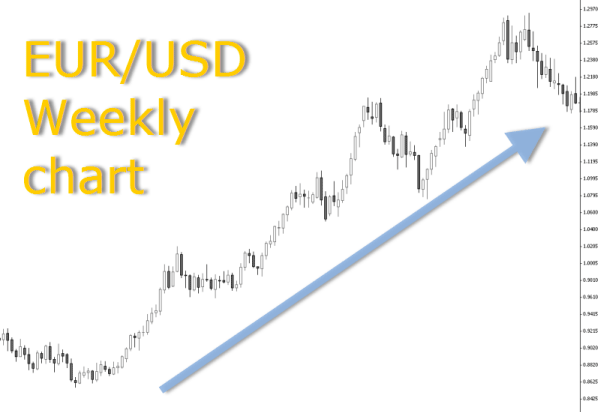
In the above example the chart illustrates the strength of the base currency, the Euro, relative to the quote currency, the US Dollar. Remember, the quote currency is the one in which the exchange rate is quoted.
The next chart shows the same base currency but this time relative to the Australian Dollar. Both charts comprise the same period and as you can see, the value of the Euro has shown a different behavior towards the USD than towards the AUD.
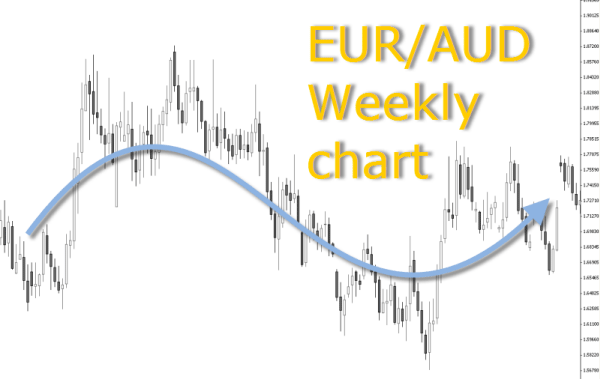
In a free floating system, there are two main factors that can affect exchange rates every day: international trade (import/export of commodities, manufactured goods and services) and capital flows (following certain interest rates, equity performance, government debt instruments like bonds).
It is by buying and selling a currency, therefore exchanging it with other currencies, that it becomes stronger or weaker, independently from the fact of this transaction being speculative or not.
Basically there are two main methods to estimate where a currency is heading: analizing the economic fundamentals and analyzing the price action through technical analysis.
The first refer to the economic and political factors that influence the value of currencies, such as the release of economical data and news. Currencies reflect the performance and policies of entire economies, sovereign governments and industry. It is the comparison of different currencies and their economies that drives exchange rates up and down.
The second are graphical representations of the exchange rates like you see above. Price charts show supply and demand levels represented through price patterns which can be recognized visually. As a numerical sequence, price series can be also technically analyzed using mathematical formulas, represented by technical indicators.
In Unit C, you will be familiarized with such fundamental and technical analytical resources. They will help you to interpret the market in a meaningful way. But before you start to interpret, there is a lot of information about price action that you can obtain simply through observation. Chapters A03 and A04 will teach you just that.
Trading Forex is in fact like trading entire economies. A huge difference compared to equities - where companies are traded - is that trends in Forex can last very long. Due to the fact that macroeconomic events can continue to influence the market over a time frame of months and years, an economy that is weak tends to stay weak for a long time. A company that is in trouble can be turned around fairly quickly, but not an entire economy.
Many retail traders feel the need to buy and sell bottoms on the charts, hopping for a turn-around, but the fact is that a currency that has been weakening can always go lower in value, and one that has been gaining strength can always go higher too. The lesson here is that if you want to fight trends in the Forex world, be sure to have a sound and tested method able to capitalize on such circumstances.
Observe the market closely. To achieve success in Forex, you must become an astute observer. Download a free charting platform and take notes each day on the patterns and the constants you discover. In the beginning you will see just candles making mountains and valleys on the chart, with no further meaning, but with time and persistence, patterns will start to emerge and you will be able to pick up behavior constants from the charts. Start focusing on one or two pairs only, and don't overflow you with too much information. To trade for a living you won't need to trade with 10 pairs at once. In fact, many professional traders specialize in only one or two currency pairs.
Before proceeding further into the mechanics, let's devote a moment to the currency pairs themselves.
Currency Pairs
The following is a list of the most frequently traded currencies, their trading symbols, their nicknames and major characteristics:
USD (US Dollar)
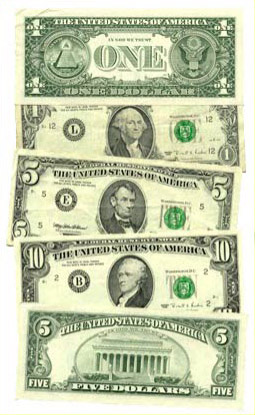
The US Dollar is by far the most transacted currency in the world. This is due to several factors as you have already learned in the last chapter. First, it's the world's primary reserve currency, which makes this currency highly susceptible to changes in interest rates. Second, the USD is a universal measure to evaluate any other currency as well as many commodities such as oil (hence the term "petrodollar") and gold.
Today's other major currencies like the Euro, the British Pound, the Australian Dollar and New Zealand Dollar are moving against the American currency, and so do the Japanese Yen, the Swiss franc and Canadian Dollar.
70% of the U.S economy depends on domestic consumption, making its currency very susceptible to data on employment and consumption. Any contraction in the labor market has a negative effect on this currency.
All US Dollar denominated bank deposits held at foreign banks or foreign branches of American banks are known as "Eurodollars". Some economists maintain that the overseas demand for Dollars allows the United States to maintain persistent trade deficits without causing the value of the currency to depreciate and the flow of trade to readjust. Other economists believe that at some stage in the future these pressures will precipitate a run against the US Dollar with serious global financial consequences.
Nickname: Buck or Greenback
EUR (Euro)
The European Monetary Union is the world's second largest economical power. The Euro is the currency shared by all the constituting countries which also share a single monetary policy dictated by the European Central Bank (ECB).
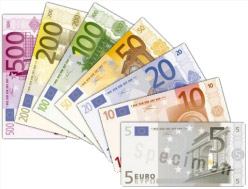
This currency is both a trade driven and a capital flow driven economy. Before the establishment of the Euro, central banks didn't accumulate large amounts of every single European national currency, but with the introduction of the Euro it is now reasonable to diversify the foreign reserves with the single currency. This increasing acceptance as a reserve currency makes the Euro also very susceptible to changes in interest rates.
The effect of the Euro competing with the Dollar for the role of reserve currency is misleading. It gives observers the impression that a rise in the value of the Euro versus the US Dollar is the effect of increased global strength of the Euro, while it may be the effect of an intrinsic weakening of the Dollar itself.
Nickname: Fiber or Single Currency
JPY (Japanese Yen)
The Japanese Yen, despite belonging to the third most important single economy, has a much smaller international presence than the Dollar or the Euro. The Yen is characterized by being a relatively liquid currency 24 hours.
Since much of the Eastern economy moves according to Japan, the Yen is quite sensitive to factors related to Asian stock exchanges. Because of the interest rate differential between this currency and other major currencies that preponderated for several years, it is also sensitive to any change affecting the so-called "Carry Trade". Investors were then shifting capital away from Japan in order to earn higher yields. However, in times of financial crisis when risk tolerance increases, the Yen is not used to fund carry trades and is punished accordingly. When volatility surges to dangerous levels, investors try to mitigate risk and are expected to park their money in the least risky capital markets. That means those in the US and Japan.
The concept of carry trade will be disclosed later in this chapter, but a short definition would be: a strategy which involves buying or lending a currency with a high interest rate and selling or borrowing a currency with a low interest rate.
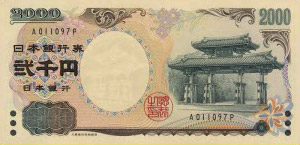
Japan is one of the world's largest exporters, which has resulted in a consistent trade surplus. A surplus occurs when a country's exports exceed its imports, therefore an inherent demand for Japanese Yen derives from that surplus situation. Japan is also a large importer and consumer of raw materials such as oil. Despite the Bank of Japan avoided raising interest rates to prevent capital flows from increasing for a prolonged period, the Yen had a tendency to appreciate. This happened because of trade flows. Remember, a positive balance of trade indicates that capital is entering the economy at a more rapid rate than it is leaving, hence the value of the nation's currency should rise.
These are the milestones in the Yen's 137-year history, from 1871 until the December, 12 2008 when the Yen hit a 13-year high versus the US Dollar.
In some countries the fiscal year and calendar year are not identical. In Japan the start of a new fiscal year is April 1st. Japanese companies usually ‘dress up’ their balance sheets ahead of the fiscal year-end, by liquidating foreign holdings and bringing home the profits from overseas subsidiaries, in order to raise their bottom lines. This capital flows prior to the start of the new fiscal year, and the fact that banking trading desks lower their transaction volumes, condition the exchange rates and price action in all pairs containing the Yen.
GBP (Pound Sterling)
This was the reference currency until the beginning of World War II, as most transactions took place in London. This is still the largest and most developed financial market in the world and as a result banking and finance have become strong contributors to the national economical growth. The United Kingdom is known to have one of the most effective central banks in the world, the Bank of England (BOE).
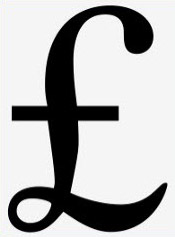
The Sterling is one of the four most liquid currencies in the Forex arena and one of the reasons is the mentioned highly developed capital market.
While 60% of the volume of foreign exchange are made via London, the Sterling is not the most traded currency. But the good reputation of the monetary policy of Great Britain and a high interest rate for a long time contributed to the popularity of this currency in the financial world.
Nickname: Cable or simply Sterling
Even though the economic unit using the Pound Sterling is technically the United Kingdom rather than Great Britain, the ISO currency code is GBP and not UKP as sometimes abbreviated. The full official name of the currency "Pound Sterling", is used mainly in formal contexts and also when it is necessary to distinguish the United Kingdom currency from other currencies with the same name such as the Guernsey Pound, Jersey Pound or Isle of Man Pound.
The currency name is sometimes abbreviated to just Sterling, particularly in the wholesale financial markets, while the term British Pound is commonly used in less formal contexts, although it is not an official name for the currency.
CHF (Swiss franc)
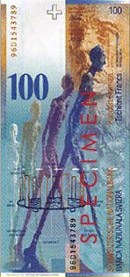
Several factors such as a lengthy history of political neutrality and a financial system known for protecting the confidentiality of its investors, have created a save heaven reputation for Switzerland and its currency. Being the worlds largest destination of offshore capital.
The Swiss franc moves primarily on external events rather then domestic economic conditions, and is therefore sensitive to capital flows as risk-averse investors pile into Franc-denominated assets, during global risk aversion times. Also much of the debt from Eastern European economies is denominated in Swiss Francs.
Nickname: Swissy
CAD (Canadian Dollar)
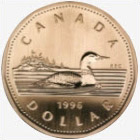
Canada is commonly known as a resource based economy being a large producer and supplier of oil. The leading export market for Canada is by far the United States making its currency particularly sensitive to US consumption data and economical health.
Being a highly commodity dependent economy, the CAD is very correlated to oil - meaning that when oil trends higher, USD/CAD tends to trend lower and vice versa.
Nickname: Loonie
If Canada is one of the world's largest producers of oil and is such a big part of the US economy, rising oil prices tend to have a negative effect on the USD and a positive effect on the CAD. Here you have two nice correlations.
But if you are willing to find a pair which is really sensitive to oil prices, then pick the CAD/JPY. Canada and Japan are at the extreme ends of production and consumption of oil. While Canada benefits from higher oil prices, Japan's economy can suffer because it imports nearly all of the oil it consumes. This is another interesting correlation to follow. A brent crude oil spot chart is available at our World Indexes section.
The nickname "Loonie" is derived from the picture of a loon, a distinctive bird which appears on one side of the Canada's gold-colored, one Dollar coin.
AUD (Australian Dollar)

Australia is a big exporter to China and its economy and currency reflect any change in the situation in that country. The prevailing view is that the Australian Dollar offers diversification benefits in a portfolio containing the major world currencies because of its greater exposure to Asian economies. This correlation with the Shanghai stock exchange is to be added to the correlation it has with gold. The pair AUD/USD often rises and falls along with the price of gold. In the financial world, gold is viewed as a safe haven against inflation and it is one of the most traded commodities. Together with the New Zealand Dollar, the AUD is called a commodity currency. Australia's dependency on commodity (mineral and farm) exports has seen the Australian Dollar rally during global expansion periods and fall when mineral prices slumped, as commodities now account for most of its total exports.
What is a commodity currency? A commodity currency is a currency whose country's exports are largely comprised of raw materials (precious metals, oil, agriculture, etc.).
Among the most actively traded and therefore liquid currencies are the NZD, the AUD and the CAD. "Commodity Dollars" or "Comdolls" is another term to describe these currencies.
The interest rates set by the Reserve Bank of Australia (RBA) have been the highest among industrialized countries and the relatively high liquidity of the AUD has made it an attractive tool for carry traders looking for a currency with the highest yields. These factors made the AUD very popular among currency traders. It's the 6th most traded currency in the world accounting for an estimated 6.8% of worldwide FX transactions in 2007, far in excess of the economy's importance (2% of global economic activity).
The AUD is under a free floating regime since 1983. Before that it was pegged to a group of currencies called the trade weighted index (TWI).
Nickname: Aussie
NZD (New Zealand Dollar)
This currency behaves similar to the AUD because New Zealand's economy is also trade oriented with much of its exports made up of commodities. The NZD also moves in tandem with commodity prices.
As per estimates from the last BIS triennal survey, in 2007 the NZD accounted for a daily transaction share volume of 1,9% of total Forex transactions, after the Norwegian Krone, the Hong Kong Dollar and the Swedish Krone.
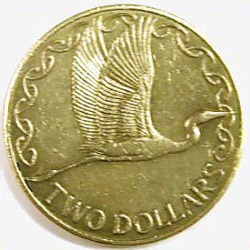
Along with the Australian Dollar, the NZD has been for many years a traditional vehicle for carry traders, which has made this currency also very sensitive to changes in interest rates. In 2007 the NZD was mainly used to conduct carry trades against the Japanese Yen accounting for a higher volume than the Australian Dollar against the Yen.
Nickname: Kiwi
Although there are many currencies worldwide, the vast majority of all daily transactions involve the exchange of the so called "major" currency pairs:
|
The pair is always expressed with the convention: Base currency / Quote currency set by the Society for Worldwide Interbank Financial Telecommunication cooperative (SWIFT).
The EUR/USD is the most liquid currency pair and all pairs containing the EUR are very liquid. This currency is the result of the replacement of all largest European national currencies, such as the Deutsche Mark, French Franc, Italian Lira, Dutch Guilder, the Belgian Franc, among others. The conversion of these legacy currencies into one, coupled with the ongoing process of deregulation of cross-border transactions, enhanced market efficiency and helped the single currency challenge the supremacy of the US Dollar in international transactions. As described in the BIS quarterly review of December 2007, "...the Euro area market currently accounts for 16% of total international interbank activity, up from 10% in 1998. Much of this has been fueled by greater use of the Euro, whose share in the interbank market hovered around 70% until 1998, but then increased steadily and has stabilized at 86% since 2003."
According to the last triennial survey from 2007 made by the Bank of International Settlements, this is the daily turnover in the Forex market per major pairs.
|
For traders, the best trading opportunities are those related to the major currencies, because those are traded more frequently and are therefore more liquid.
What is a liquid currency? - It's a currency which can be bought and sold with ease at any time, because there is always a counterpart for the transaction. In other words, there are more buyers and sellers in a liquid market than in an illiquid one. The terms "thick" or "deep" are also commonly used to designate a high degree of liquidity.
Other currency pairs are referred to as "minors" or "exotic" pairs. These are some of the lesser-traded pairs that contain the USD and a currency from a smaller and/or emerging economy:
|
Other pairs where the US Dollar is not a member currency are called "crosses". Basically, a cross is any currency pair in which the US Dollar is neither the base nor the counter currency. For example, GBPJPY, EURJPY, EURCAD, and AUDNZD are all considered currency crosses.
When you think about buying or selling a cross currency pair, don't forget that the US Dollar, despite not being a member within the pair, is still influencing the price behavior of the cross. Buying EUR/JPY is equivalent to buying the EUR/USD currency pair and simultaneously buying the USD/JPY. Knowing from the previous chapter how interbank platforms work, you also understand why cross currency pairs frequently carry a higher transaction cost. To build a cross, interbank dealers have to combine two orders on different platforms.
The figure below shows the process of creating a cross currency pair.
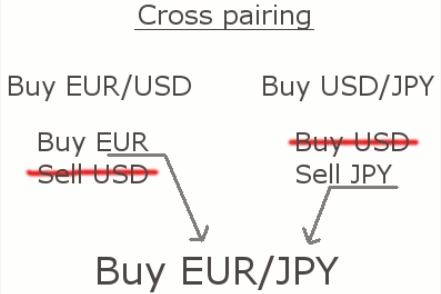
By knowing how currencies are related and transacted you will be given a basic understanding on how to analyze trading opportunities on majors as well as on crosses. The principles guiding you to profit from a trade with a cross should be technically the same as with the majors: basically you want to analyze which is the strong and which is the weak currency within the pair.
By the same token, as crosses are created at the interbank level, you can create your crosses if they are not available with your preferred broker-dealer's platform. We call that creating "synthetic" pairs.
Let's assume a trader believes, based on a previous analysis, that there is an opportunity to profit from a weak Swedish Krone (SEK) and a strong Norwegian Krone (NOK), but the broker-dealer which the trader is using doesn't enable to sell the pair SEK/NOK. In this case all it takes is the trader to buy USD/SEK and to sell USD/NOK with equal position sizes. The position size depends on the pip value of the pair you are trading, as you will see later in this chapter.
Too many new concepts to put down a profitable trade? Don't worry, we will get there in a moment.
The figure below illustrates the process of synthetic pairing.
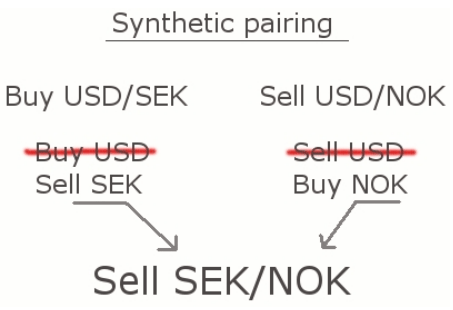
Again, for a detailed view on all pairs and possible crossings:
Exotic currency
or
World currency
or even
Currency rates
If you trade several pairs simultaneously, don’t get overweight in one currency, unless the risk has been diversified. For instance, buying the EUR/USD and being short in the USD/CHF is like having twice the exposure to the same factors, as these pairs are highly correlated.
You'd better monitor several pairs and trading just one, for instance, by following the EUR/GBP when trading the GBP/USD. Although the GBP/USD is a more liquid currency than EUR/GBP, EUR/GBP is typically a good indicator for GBP strength.
To get a feel for currency correlations, how they move in relation to each other, start familiarizing yourself with the US Dollar Index. Sunil Mangwani explains both concepts in his work: "Important Things To Know About Your Currencies":
The US Dollar Index measures the performance of the US Dollar against a basket of world currencies. This basket consists of the following currencies and their percentage weighting.
Euro 57.6%
Japanese Yen 13.6%
Great Britain Pound 11.9%
Canadian Dollar 9.1%
Swedish krona 4.2%
Swiss franc 3.6%
...Since the Euro makes up a major portion of this basket, it is rather obvious that it should have a strong correlation with the US Dollar Index.
Dan Blystone also explained the US Dollar Index during a chat dedicated to Forex trading correlations:
The US Dollar Index (USDX) is a futures contract offered by the New York Board of Trade. It is a trade-weighted average of six foreign currencies against the Dollar. Currently, the index includes Euros (EUR), Japanese Yen (JPY), British Pounds (GBP), Canadian Dollars (CAD), Swedish kronas (SEK) and Swiss francs (CHF).
...
USDX broadly reflects the Dollar's standing compared to the other major currencies of the world. It is widely used to hedge risk in the currency markets or to take a position in the US Dollar without having the risk exposure of a single currency pair.
...
The US Dollar Index allows the fx trader a feel for what is going on in the FX market globally at a glance. If the Dollar Index is trending lower, then it is likely that a major currency that is a component of it is trading higher.
In the assessment modules of Practice Chapter A, a lot of questions will be drawn on this material. Don't be afraid to practice with them as many of the questions show extra explanations at the fullfilment of the assessment.





